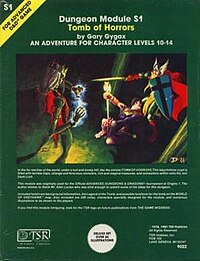
Review: S1 Tomb of Horrors
I have mixed feelings on S1. It's one of the first adventures I owned. I ran it multiple times (my cousin's thief Blackstar went there at least once, and lived). I think I mis-ran parts of it because of the difficulty of the text. It was fun, but it was also a bad influence on us. It set the tone for a lot of play - traps were lethal, often with no save; treasures could sometimes be stingy; games were meant to be hard.
It certainly had to influence the killer dungeons back in the day. DMs often bragged about how lethal their dungeons were. PCs were playing pieces to be expended trying to beat the dungeon. S1 was an example of the type, even if it's more of a puzzle than a monster maze meant to dice up your characters through combat.
But it's an interesting dungeon. It's tough, but it's not impossible. It punishes greed and lack of caution. It's a thinking person's dungeon, and quite possible to get through if you're careful and the GM is fair. It deserves the designation "S" for "Special" but for us elementary school aged gamers it was just one more example of How to Play the Game Right. The modules were gospel, and this was a gospel of strict and lethal play.
It's a module I'd like to run for an experienced group. I like what it's inspired (The Mud Sorcerer's Tomb is an homage that one-ups the original in many ways). But again, it may have been better if we'd never touched it back in the day. We'd have done better with something less special and less lethal.
The lethality of S1 reminds me of something I have only recently understood about an inherent contradiction in Old School play. The following are all Old School tropes:
ReplyDelete1. You start at first level.
2. Leveling up takes a while.
3. Adventures are lethal.
If all of these are true, most PCs never make it to the higher levels, and the higher lvl. modules can't be played "honestly" due to a lack of appropriate PCs.
This led to a lot of play where 1 or more of the above principles were ignored, and eventually most folks moving away from old school style play because the cool higher level stuff was not really possible.
I agree and disagree.
DeleteI agree in that one or more of those principles were ignored in a lot of campaigns.
But I don't think #3 is really correct. I think it is, "Adventures can be lethal." There is an expectation that there is real risk to your character. You can and should mitigate the risk as much as possible (prepare, show cunning in play, know when walk away and come back another time) and can and should prepare to undo damage (get access to Raise Dead, Limited Wish or Wish, etc. ASAP). An adventure you walk away from is a good one. One you die during but get raised after is one you effectively walk away from.
You can add a fourth element - 4. Player skill is critical. There is the assumption the test inherent in the game is of you, the player, not your playing piece.
I think this is a tough combination, and it's not always clear that was the intent. My idea now of how D&D was meant to be played back in the day doesn't match how we actually played D&D back in the day. We had 1st level, nobody got raised from the dead until a PC could do it, people regularly hopped campaigns, people played in modules they'd read and meta-gamed everything, nobody used hirelings like bullets (something I understand Rob Kuntz did to clear the Tomb of Horrors with his PC plus some orcs), and player skill was a matter of pre-game book reading because we didn't allow much leeway for creative solutions that fell outside the rules.